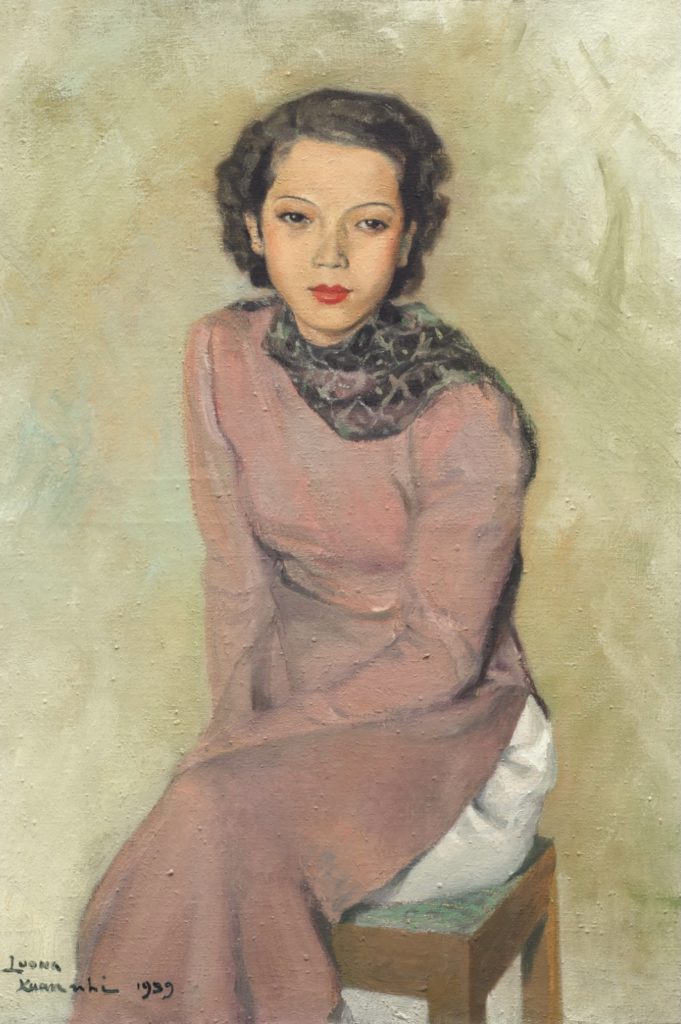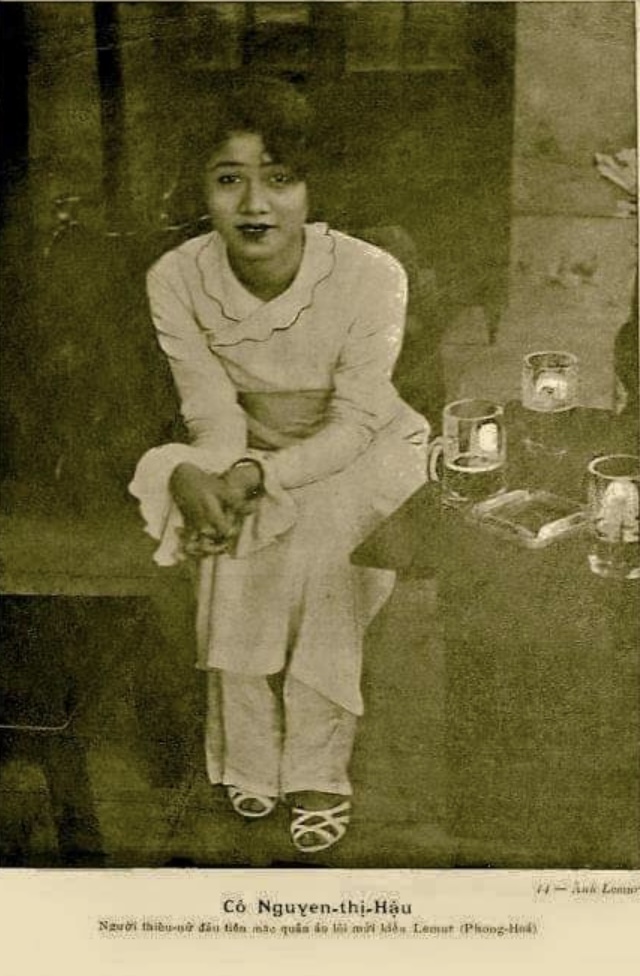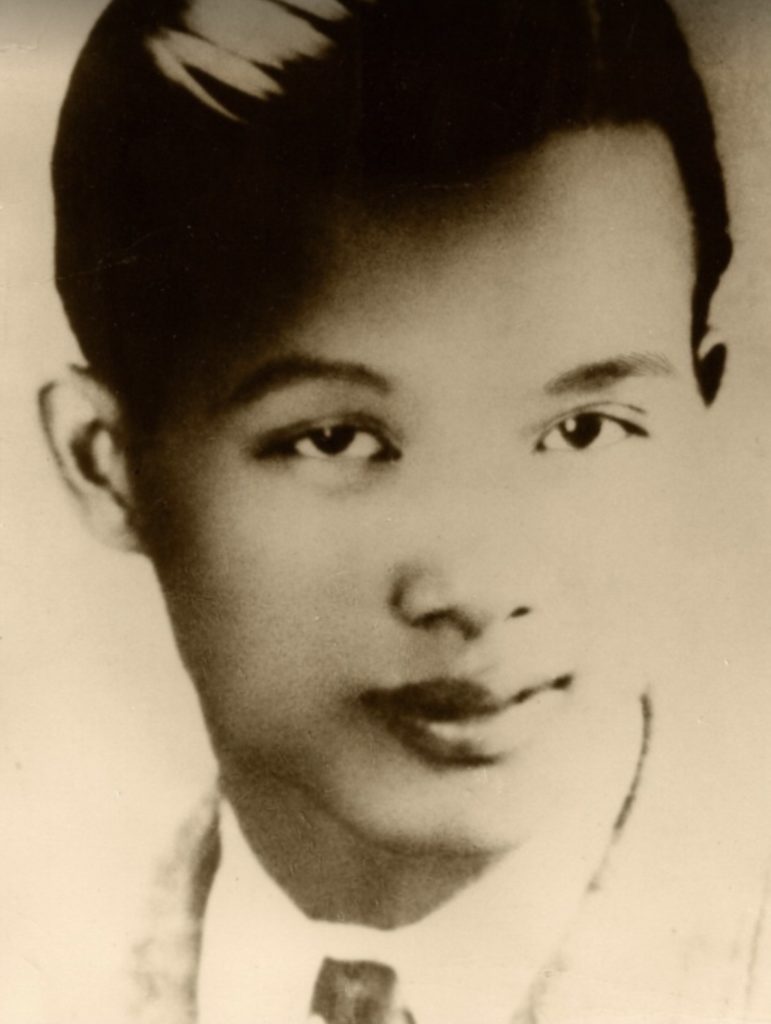Nguyen Cat Tuong (LeMur), 1940 « Mother And Child », Or the form surpasses the background
Through this large format ink and gouache on silk (74,5 X 38,5cm), signed and dated 1940 (lower right), we can make our way to a better understanding of a man who was not only a talented painter but also one of these – very rare… – social actor with the capacity of changing society, in this case, the Vietnamese urban society of the 1930s.

The uniqueness of this painting is the importance of fabric, used for finishing or to wear, chosen as the central theme. The decor is structured by the characters. The plot is the bed and the lady’s clothes. In a way the lady and the child are not individuals but mannequins (figuratively speaking). Nguyen Cat Tuong states that the form translates the reality and the designer that he is – also – it play a political role (too often underestimated). First of all, clothing is a social message. An irrefutable attribute. To shape it, to refine it, even to impose it and to exclude one self or others from it : this is true activism. The color, the cut, a fringe, a hem, a shoe, every detail becomes a political instrument.
Nguyen Cat Tuong (1912-1946), alias LeMur, was born in 1912 in Son Tay. He graduated from the Indochina School of Fine Arts (fourth class, 1928-1933) where he was a fellow student of Nguyen Tuong Lan (1906-1946). Both belonged to the nationalist literary group, founded in 1932, the Tu Luc Van Doan (Autonomous Literary Group). It is not a known fact but of the 7 founding members of the movement, Nguyen Tuong Tam, Khai Hung, Nguyen Tuong Lan, Nguyen Tuong Long, Tu Mo, Nguyen Gia Tri and Nguyen Thu Lê, 4 were graduates (even if they did not graduate…) of the Hanoi School of Fine Arts. Nguyen Tuong Tam (1906-1963), better known as Nhat Linh, was the most active: he took over the periodical Phong Hoà (Morals), and created the periodical Ngay Nay (Today), whose existence was shortened by the French censorship (they were banned in 1934 and 1936 respectively). These newspapers were essential – the press was flourishing at the time – in promoting the ideals of Tu Luc Van Doan. And advocating the modernization of Vietnamese society, culture and literature implied “Recognizing the role of women in society as stated in point 6 of the movement’s “Ten Precepts to Ponder” established by Hoang Dao (one of Nguyen Tuong Long’s pen names) in 1936-1937. The choice of women’s clothing and therefore their visual inclusion in society is not negligible and Cat Tuong knew how to use these media to make it known.
In our work, here, the painter celebrates his victory at the end of a decade that has seen his ao dai conquer its audience. And for this celebration he uses an almost exacerbated polychromy.
The colors of the bed’s trimmings with their traditional motifs – the phoenix, the clouds and the “flaming pearl” – with their mantling, their bangs, their geometric braid and their tassels are strong. All this iconographic or symbolic classical repertoire serves as a framework for modernism:

The woman’s flowered ao dai, half-open at the waist. A scarf tied around the neck. The white pants, the shoes with heels. Her discreet make-up, her plucked eyebrows. Her hairstyle not « à la garçonne » yet by a slight lack of confidence as already showed by Luong Xuan Nhi but in deconstruction of the classic chignon.
Nguyen Cat Tuong does not present his model seated, staring at the painter. No, he shows her as an attentive mother, in profile, in a traditional interior: the painter confirms his philosophy: modernity must not wipe out the past.
The 1930-40 in Vietnam are resolutely years of anti-Confucianism and independence – evoked, claimed or demanded – within almost all Vietnamese social strata. Cat Tuong, for his part, chose the path of clothing in the context of this quest. On one hand, « Modern » Vietnamese men have most often converted to Western-style clothing. On the other hand, the « modern » Vietnamese woman stayed committed from the national past but wanted to evolve by following Cat Tuong who, if he did amplified an existing movement, also gave it new meaning: the traditional ao dai is not just readampted. It is reinvented. The old one projected the ancestral notion of an institutional femininity: the « honest » woman had to be wise, innocent, submissive (to her father, her husband, her uncle, her brother…) and far from any form of physical attractiveness. She had to remain true to the old Vietnamese saying “Cái nết đánh chết cái đẹp” (virtue before beauty).
In his reworked version of the ao dai, Cat Tuong modifies the bodice so that it skims the contours of the female body before splitting into two flaps that separate at the hip and fall over the pants. Nguyen Van Ky, in his book “La Société Vietnamienne face à la Modernité, le Tonkin de la fin du XIX ème à la Seconde Guerre mondiale” (L’Harmattan Paris, 1999) offers us (pp 247-260) presents an excellent mental synthesis (so many prejudices to combat…), social (from Vietnamese women married to the French, to young single women) and geographical (from Hanoi to Saigon via Danang) installation of the progressive ao dai LeMur during the 1930s. It also recalls the Chinese beginnings, as the Chinese are engaged in a similar movement since the 1920s.
The new garment crystallizes many of Tu Luc Van Doan‘s ideals.
In an article in Phong Hoà (issue 90, March 23, 1934), titled “Y phục cua phụ nữ” (women’s clothing), Cat Tuong wrote: « contrary to the opinions of Vietnamese moralists, Westerners agree that the chest is essential to a woman’s beauty. » (translation Nguyen Van Ky). As we can see, the West can also be liberating and the dialectic of coercion and emancipation is at the heart of the colonial problem.
A photo, for example, of the Cat Tuong’s ao dai of, worn by a young woman, appeared in the January issue – dated 30 December 1935 – of Ngay Nay.

Promoted, worn, assumed, Cat Tuong’s ao dai allows women to show their beauty, to exercise their sensuality, to model the world in their image. The retrograde idea of a woman as a man’s physical appendage is gradually becoming obsolete in the still Confucian society of the time. And the performance is great as the archaic mentality is heavy. Seen through the eyes of beauty, a woman is not only an obedient daughter, a faithful wife or a devoted mother, but a person.
Nguyen Cat Tuong modernizes Vietnamese society.

Cat Tuong obviously left few graphic works. More sketches than drawings and, also, our painting. However, did he imagine in his early days in his store at 16 Le Loi Street in Hanoi that his ao dai would become the Vietnamese woman’s accessory ? Vietnam’s symbol such a drum of Dong Son or Halong Bay?
When he painted this picture, he was 28 years old. He had 6 years to live.
The causes of his death are not clear. The reported facts maintain the controversy: his presence near Hai Duong after the evacuation of Hanoi – ordered by the Vietminh – in December 1946 is proven. The official Vietnamese historiography speaks of a « militia » that seized the painter-designer while he was trying to obtain clothes and medicine on his way home to Hanoi… Most likely Cat Tuong was one of the many victims of the clashes between Nationalists and Communists. So many of them were murdered in those troubled times. And many had to flee like Nguyen Gia Tri and my friend Jean Volang in Hong Kong…
December 17, 1946 was a disastrous day for Vietnamese painting, fashion and society. The painter, who died at the age of 34, still had so much to contribute to his country.
Fortunately, yes, the form surpasses the substance and sculptor of the living, Nguyen Cat Tuong has revolutionized the social “fabric” of his society. An extraordinary success that testifies, once again, to the extraordinary success of the Hanoi School of Fine Arts of Victor Tardieu.
Painters, sculptors, teachers, politicians, poets and also… a stylist: All the alumni of the School have contributed to Vietnamese culture.
Jean-François Hubert

PS: Cát Tường means « sign of bright future, luck, success, good omen, promising opportunities »… If we separate the two words, Tường means « the wall » literally in terms of direct translation. In most cases, this makes no sense when we compare the whole word and the meaning of each two separate words.